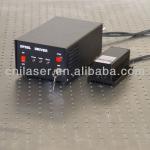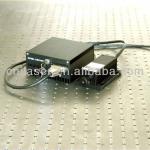Aurora4000 UV-NIR Spectrometer
| Place of Origin:Jilin China (Mainland) | Brand Name:CNI | Model Number:Aurora4000 | Range Broadband:200~1100nm |
| Resolution:0.75nm FWHM |

Aurora4000 UV-NIR Spectrometer
Aurora4000 spectrometer is developed by Jilin Lasertech Opto-Mechatronics equipment Co., Ltd. With3648 pixels CCD linear array detector, it has high resolution up to 0.02 nm (FWHM). The system includes incident slit, collimating mirror, dispersion element (grating), focusing optical system and detector. Light is collected through the optical fiber into the spectrometer slit then the spectral information can be read out by the software.
Features:
♦Wide range (200~1100nm) broadband
♦High resolution (0.75nm FWHM)
♦Robust package
Applications:
♦Spectral analysis
♦Wavelength inspection
♦Absorbance measurements
♦Reflectivity measurements
♦LED analysis
Available Model:
General seriel Aurora4000 GE UV-NIR
External Triggering seriel Aurora4000 TG UV-NIR
Standard Specifications:
Physical | |
| Dimensions | 154 mmx 110 mm x 42.6 mm |
| Weight | 840g |
Detector | |
| Detector | Toshiba TCD1304GP linear CCD array |
| Pixels | 3648 pixels |
| Pixel size | 8 μm x 200 μm |
| Pixel well depth | ~100,000 electrons |
| Sensitivity | 130 photons/count at 400 nm; 60 photons/count at 600 nm |
Optical Bench | |
| Design | f/4, Symmetrical crossed Czerny-Turner |
| Focal length | 101.6 mminput and output |
| Entrance aperture | 5 µm wide slit |
| Grating(mm-1) | 300 |
| Filter | 200-1100nm |
| Fiber optic connector | SMA 905 to 0.22 numerical aperture single-strand fiber |
Spectroscopic | |
| Wavelength range | 200-1100 nm |
| Optical resolution | <0.75 nm FWHM |
| Signal-to-noise ratio | 300:1 (at full signal) |
| A/D resolution | 14 bit |
| Dark noise | 12 RMS counts |
| Dynamic range | 2 x 10^9 (system); 1300:1 for a single acquisition |
| Integration time | 3.8 ms to 10 s |
| Stray light | <0.05% at 600 nm; <0.10% at 435 nm |
| Corrected linearity | >99.8% |
Electronics | |
| Power consumption | 450 mA @ 5 VDC |
| Data transfer speed | Full scans into memory every 4 milliseconds with USB 2.0; every 18 milliseconds with USB 1.1 |
| Inputs/outputs | 10 onboard digital user-programmable GPIOs |
| Analog channels | One 13-bit analog input one 9-bit analog output |
| Strobe functions | Yes |
| Connector | 30-pin connector |
Other slit and grating options for improved optical resolution
| Entrance slit (μm) | Grating (mm-1) | Spectral range (nm) | Optical resolution (FWHM) (nm) |
| 5 | 300 | 200~1100 | 0.75 |
| 10 | 300 | 200~1100 | 0.912 |
| 5 | 300 | 350~1100 | 0.411 |
| 10 | 300 | 350~1100 | 0.659 |
| 5 | 600 | 400~837 | 0.239 |
| 10 | 600 | 400~837 | 0.442 |
| 5 | 1200 | 300~515 | 0.117 |
| 10 | 1200 | 300~515 | 0.216 |
| 5 | 1800 | 700~790 | 0.05 |
| 10 | 1800 | 700~790 | 0.0925 |
| 5 | 2400 | 600~656 | 0.029 |
| 10 | 2400 | 600~656 | 0.053 |
Triggering options are as below
| Triggering Mode | Description | Applicable Spectrometer(s) |
| Normal | Spectrometer acquires spectra continuously. | GE+TG |
| External Software | Integration time is set in the software. Software receives a trigger event and transmits spectra obtained in the data acquisition cycle in which the trigger occurred. | GE+TG |
| External Hardware | Integration time set via chip in spectrometer. Spectrometer waits for a sharp rise in voltage on the trigger input pin, and then acquires spectra until the voltage is removed. | TG |
| External Synchronization | Spectrometer acquires data from an external trigger event until the next time the trigger is activated, at which time the spectrometer ceases spectral acquisition and begins a new acquisition. Integration time cannot be set, since the trigger can fire at random intervals. | TG |

| Packaging Detail:vaccum anti-static |
| Delivery Detail:1-2 weeks |














